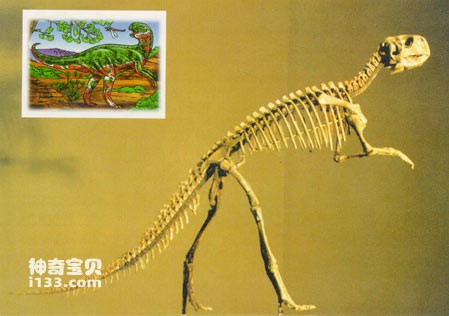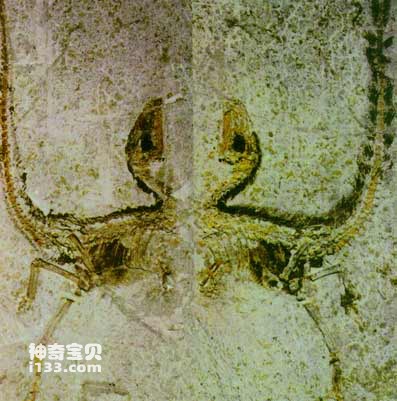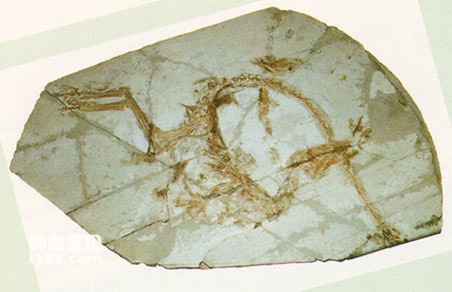The Jehol Group in western Liaoning is a famous Mesozoic continental stratum in China and has always occupied an important position in the history of paleobiostratigraphy research in China. However, although this formation has produced numerous plant fossils, invertebrate fossils and fish fossils, the discovery of dinosaur fossils was rare before 1996.

Psittacosaurus mongolica
Psittacosaurus is one of the limited dinosaur species discovered in the past. In the past, it was only found in the Lower Cretaceous Jiufotang Formation of Meileyingzi, Shengli Township, Chaoyang County, Liaoning Province. Psittacosaurus belongs to the ornithischian ceratopsian suborder and is a type of bipedal vegetarian dinosaur. Psittacosaurus from the Jiufotang Formation includes two genera and species, namely Psittacosaurus mongolica and Psittacosaurus meileyingzi.
Since the mid-1990s, the "Land of Sleeping Dragons" in the Jehol Group in western Liaoning has suddenly woken up. In just 5 to 6 years, a large number of dinosaur fossils were discovered, which not only greatly enriched our understanding of the dinosaur world, but also provided sufficient evidence for the theory that birds originated from dinosaurs.
The discovery of "Sinosauropteryx" and the dramatic research process are responsible for the rise of dinosaur craze in the Rehe Group in western Liaoning. The true specimen of "Chinese Dragon Bird" was unearthed in 1996 by local farmer Mr. Li Yinfang. The excavated site was the lower shale layer of the Sihetunyi County Formation, Shangyuan Town, Beipiao City, Liaoning Province. For various reasons, half of this specimen (the positive membrane) was collected by the China Geological Museum, and the other half (the negative membrane) was acquired by the Nanjing Institute of Geology and Palaeontology, Chinese Academy of Sciences. Sinosauropteryx was initially considered by Ji Qiang and other researchers to be the most primitive bird on earth, but was later corrected to be a dinosaur in the theropod Compsognathidae.

Sinosauropteryx
Sinosauropteryx is as big as a chicken, and its fossil shape also looks like a rooster crowing the dawn - with its head held high and its tail raised. Its head is large, and its upper and lower jaws are covered with canines with small serrations; its forelimbs are very short, and its tail is surprisingly long. On its back, there is a row of filamentous skin derivatives from head to tail. Ji Qiang and other researchers believe that they are a kind of primitive feathers.
Since then, various types of dinosaurs have been discovered in the Jehol Group in western Liaoning.
The second theropod dinosaur discovered in the lower part of the Yixian Formation is Archeopteryx robustus. It looks a lot like the Velociraptor, the star of the movie "Jurassic Park." The most surprising thing is that its tail has real feathers!

Archeopteryx
Zou's tailed bird is the second theropod dinosaur found in the world to have developed real feathers. Incredibly, the burial of Taifei Bird fossils is very concentrated. All known fossils are found in Zhangjiagou, less than two kilometers north of Sihetun, in the shale layer of the lower part of the Yixian Formation. One explanation is that the tail-feathered bird is a social animal.
The tail-feathered bird is about the same size as the primitive Archeopteryx. It may belong to the suborder Oviraptorosaurus, representing a primitive oviraptorosaur. The head of the tail-feathered bird is short and high, with only a few teeth in its mouth; its forelimbs and tail are very short. Interestingly, its stomach was also buried with a pile of small stones that were fundamentally different from the lithology of the surrounding rocks. They were obviously similar to the common gastroliths in the stomachs of modern birds, and their function was to grind and help digest food. It is extremely rare to find gastroliths in theropod dinosaurs! There is a fan-shaped tail feather at the end of the tail of the tail bird, and there is also a row of feathers on the forelimbs. These feathers have obvious rachis and developed pinnae, which are very similar to the feathers of modern birds; the only difference is that the feathers of tail-feathered birds are symmetrically distributed, while the feathers of birds including Archeopteryx are symmetrically distributed. The pinnae are distributed asymmetrically. Most scientists believe that only asymmetric feathers have the function of flying, and the symmetrical feathers of tail-feathered birds probably represent a relatively primitive stage of feather evolution and do not yet have the function of flight. On the other hand, the skeletal shape of the tailed bird also shows that it is an animal that is good at running but cannot fly.
Recently, researcher Zhou Zhonghe from the Institute of Vertebrate Paleontology and Paleoanthropology, Chinese Academy of Sciences, named a newly discovered tail-feathered bird - Tung's tail-feathered bird.
In addition, scientists have also discovered important dinosaur fossils such as Unexpected Beipiaoosaurus and Millennium Sinornithosaurus in the Jehol Group in western Liaoning. Ongoing in-depth research on them will unlock more dinosaur mysteries.
animal tags:
We created this article in conjunction with AI technology, then made sure it was fact-checked and edited by a Animals Top editor.